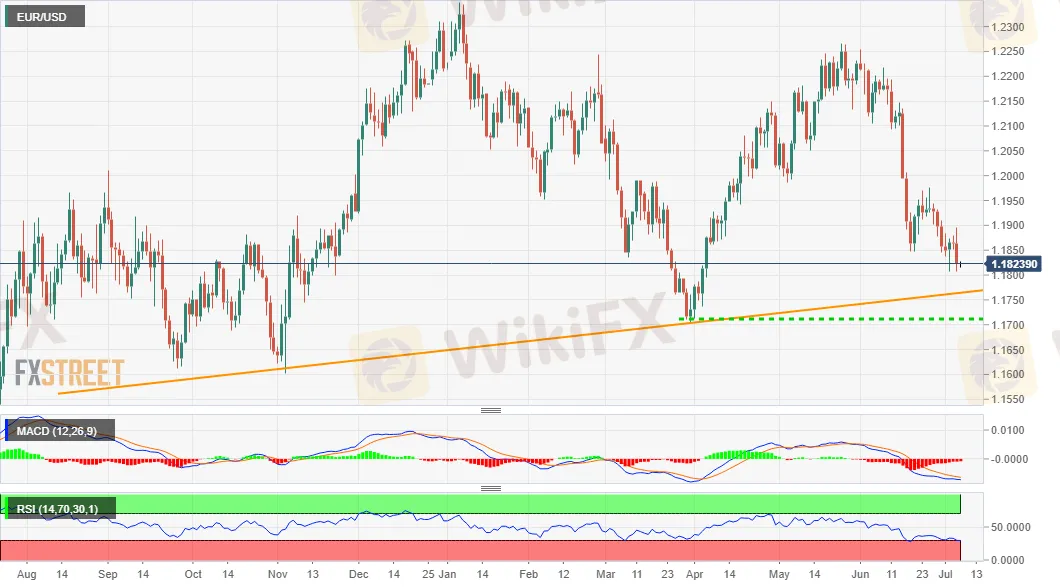简体中文
繁體中文
English
Pусский
日本語
ภาษาไทย
Tiếng Việt
Bahasa Indonesia
Español
हिन्दी
Filippiiniläinen
Français
Deutsch
Português
Türkçe
한국어
العربية
EUR/USD Forecast: Why the euro is set to enjoy a (temporary) bounce at the double-bottom
Abstract:EUR/USD Forecast: Why the euro is set to enjoy a (temporary) bounce at the double-bottom
A combination of factors prompted some fresh selling around EUR/USD on Tuesday.
Disappointing Eurozone ZEW survey results weighed heavily on the shared currency.
The risk-off mood drove haven flows towards the USD and added to the selling bias.
The downside remains limited at traders turn cautious ahead of the FOMC minutes.
The EUR/USD pair failed to capitalize on Tuesday's modest gains to the 1.1900 neighbourhood and dived back closer to the three-month lows touched last week. The shared currency weakened across the board in reaction to disappointing economic data, which, along with a goodish pickup in the US dollar demand exerted some downward pressure on the major. The shared currency weakened across the board in reaction to disappointing ZEW survey results, which showed that investors sentiment in Germany – the Eurozone's biggest economy – fell sharply in July. The index tumbled to 63.3 for the current month from 79.8 previous. Adding to this, the gauge for the broader Eurozone dropped to 61.2 for the current month, missing 84.4 consensus estimates.
On the other hand, a fresh bout of risk aversion trade drove some haven flows towards the US dollar amid concerns about the spread of the highly contagious Delta variant of the coronavirus. This was seen as another factor that further contributed to the pair's intraday decline. The USD bulls seemed rather unaffected by the risk-off mood-led slump in the US Treasury bond yields and softer US ISM Services PMI. The gauge measuring business activity in the US services sector fell short of market expectations and fell to 60.1 in June. The disappointment, however, was largely offset by a slightly better-than-expected Prices Paid sub-component.
Apart from this, diminishing odds for an earlier than anticipated policy tightening by the Fed hold the USD bulls from placing aggressive bets. This, in turn, assisted the pair to hold its neck above the 1.1800 round-figure mark through the Asian session on Wednesday. Hence, the key focus will remain on the FOMC June meeting minutes. Investors will look for clues about the Fed's monetary policy outlook, which will play a key role in influencing the USD price dynamics in the near term and provide a fresh directional impetus to the major.
Short-term technical outlookFrom a technical perspective, any subsequent decline below the 1.1800 mark is more likely to find decent support near a short-term ascending trend-line, currently around the 1.1775 region. Given that RSI (14) on the daily chart has just started drifting into the oversold territory, the mentioned area should act as a strong base for the major. A convincing break below will be seen as a fresh trigger for bearish traders and prompt some aggressive technical selling. The pair might then turn vulnerable to accelerate the slide further towards challenging YTD lows, around the 1.1700 mark touched in March.
On the flip side, immediate resistance is pegged near the 1.1860 horizontal zone, above which the pair is likely to make a fresh attempt to reclaim the 1.1900 mark. Some follow-through buying beyond the 1.1925-30 supply zone might prompt some short-covering move and allow bulls to aim back to reclaim the key 1.2000 psychological mark.

(Source: FXSTREET)

Disclaimer:
The views in this article only represent the author's personal views, and do not constitute investment advice on this platform. This platform does not guarantee the accuracy, completeness and timeliness of the information in the article, and will not be liable for any loss caused by the use of or reliance on the information in the article.
Read more

EUR/USD Forecast: Euro set to rally after weathering two storms, showing its strength
EUR/USD Forecast: Euro set to rally after weathering two storms, showing its strength

EUR/USD Forecast: Only a dead cat bounce? US Retail Sales may trigger a downfall to 1.20
EUR/USD Forecast: Only a dead cat bounce? US Retail Sales may trigger a downfall to 1.20

RIS’ Sign of Stopping Declining May Bolster up EUR/USD
European Central Bank(ECB) President Christine Lagarde warned that the appreciation of euro may bring negative pressure on commodity prices. At the same time, PRI is expected to stop the declined trend since the end of July.
WikiFX Broker
Latest News
The Withdrawal Trap: How Scam Brokers Lure Victims into Paying More
FCA to Investors: Think Twice Before Trusting These Brokers
Trump\s tariffs: How could they affect the UK and your money
Trump gambles it all on global tariffs he\s wanted for decades
TradingView Brings Live Market Charts to Telegram Users with New Mini App
Trump tariffs: How will India navigate a world on the brink of a trade war?
Interactive Brokers Launches Forecast Contracts in Canada for Market Predictions
Authorities Alert: MAS Impersonation Scam Hits Singapore
IG Group Acquires Freetrade for £160M to Expand UK Investment Market
U.S. March ISM Manufacturing PMI Released
Currency Calculator







